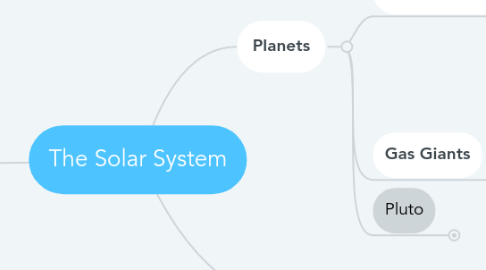
1. The Sun
1.1. The Sun is the star at the center of the Solar System. It is a nearly perfect sphere of hot plasma, with internal convective motion that generates a magnetic field.
1.2. It is the most important source of energy for life on Earth
1.3. Its diameter is about 109 times that of Earth, and its mass is about 330,000 times that of Earth, accounting for about 99.86% of the total mass of the Solar System.
2. Gravity
2.1. Gravity, or gravitation, is a natural phenomenon by which all things with mass are brought toward one another, including planets, stars and galaxies.
2.1.1. Since energy and mass are equivalent, all forms of energy, including light, also cause gravitation and are under the influence of it.
2.2. On Earth, gravity gives weight to physical objects and causes the ocean tides
2.3. The gravitational attraction of the original gaseous matter present in the Universe caused it to begin coalescing, forming stars and the stars to group together into galaxies
2.4. Gravity has an infinite range, although its effects become increasingly weaker on farther objects
3. Planets
3.1. Small Rocky Planets
3.1.1. Mercury
3.1.1.1. Mercury has a revolution period of 88 days. Mercury has extreme temperature fluctuations, ranging from 800°F (daytime) to -270°F (nighttime)
3.1.1.2. Even though mercury is the closest planet to the sun, scientist believe there's ice on mercury. The ics is protected from the heat by crater shadows.
3.1.2. Earth
3.1.2.1. Earth is the only planet known to support living organisms
3.1.2.2. Earth's surface is composed of 71% water
3.1.2.2.1. Water is necessary for life on Earth
3.1.2.2.2. The oceans help maintain Earth's stable temperature
3.1.2.3. Earth has an oxygen rich atmosphere (which we are burning a hole into)
3.1.2.4. Earths Moon
3.1.2.4.1. This is Earth's natural satellite. It revolves around Earth every 29½ Earth days and rotates every 29½ days. This is why Earthlings never see the dark side of the moon! Humans landed on the moon July 20, 1969.
3.1.2.4.2. Earths Moon Continued
3.1.2.4.3. Eclipses
3.1.3. Venus
3.1.3.1. Venus is the brightest object in the sky after the sun and moon because its atmosphere reflects light so well. People often mistake it for a star.
3.1.3.2. Its maximum surface temperature may reach 900°F
3.1.3.3. Venus has no moons and takes 225 days to complete an orbit
3.1.4. Mars
3.1.4.1. Like Earth, Mars has ice caps at its poles
3.1.4.2. Mars has the largest volcano in our solar system: Olympus Mons. Olympus Mons is approximately 15 miles high.
3.1.4.3. Mars appears red because of iron oxide, or rust, in its soil.
3.1.4.4. Mars has two moons and takes about two years to complete an orbit.
3.1.5. Characteristics of Small Rocky Planets
3.1.5.1. They are made of mostly of rock and metal
3.1.5.2. The move slowly in space
3.1.5.3. They are very heavy
3.1.5.4. They have no rings and few moons (if any)
3.1.5.5. They have a diameter of less than 13,000
3.2. Gas Giants
3.2.1. Jupiter
3.2.1.1. Jupiter is largest and most massive planet.
3.2.1.2. Its diameter is 11 times larger than that of the earth's.
3.2.1.3. It takes about 12 years for Jupiter to orbit the sun.
3.2.2. Saturn
3.2.2.1. Saturn is the sixth planet from the Sun
3.2.2.2. It is the second-largest in the Solar System
3.2.2.3. I a planet of gas, but scientists believe the core to be solid
3.2.2.4. It is predominantly composed of hydrogen and helium
3.2.2.5. Jupiter has 318 times the Earth's mass
3.2.2.6. Saturn is the only planet of the Solar System that is less dense than water—about 30% less
3.2.2.7. Wind speeds on Saturn can reach 1,800 km/h
3.2.2.8. Saturn has many rings made of ice. Saturn’s rings are very wide. They extend outward to about 260,000 miles from the surface but are less than 1 mile thick.
3.2.2.9. Saturn has 18 known moons, some of which orbit within the rings.
3.2.2.10. It takes saturn about 30 years to orbit the sun
3.2.3. Uranus
3.2.3.1. Uranus is blue in color due to methane gas in the atmosphere.
3.2.3.2. Uranus has 11 dark rings surrounding it.
3.2.3.3. Uranus has 21 known moons and takes 84 years to complete an orbit
3.2.4. Neptune
3.2.4.1. Neptune has the fastest winds in the solar system: up to 2,000 km/hr.
3.2.4.2. Neptune is also blue due to methane gas in its atmosphere.
3.2.4.3. Neptune takes 165 years to orbit the sun and has 8 moons.
3.2.4.4. It Has the Great Dark Spot. This is a violent storm of gases
3.2.4.5. There are also rings around Neptune
3.2.5. Characteristics of Gas Giants
3.2.5.1. They are made up mostly of gases (primarily hydrogen and helium).
3.2.5.2. They are very light for their size.
3.2.5.3. They move quickly in space.
3.2.5.4. They have rings and many moons.
3.2.5.5. They have a diameter of less than 48,000 km.
3.3. Pluto
3.3.1. Pluto has only one moon and takes about 249 years to orbit the sun.
3.3.2. Part of Pluto's orbit passes inside that of Neptune, so at times Neptune is the planet farthest from the sun.
3.3.3. Pluto was located and named in 1930, but today Pluto is no longer considered a planet.

